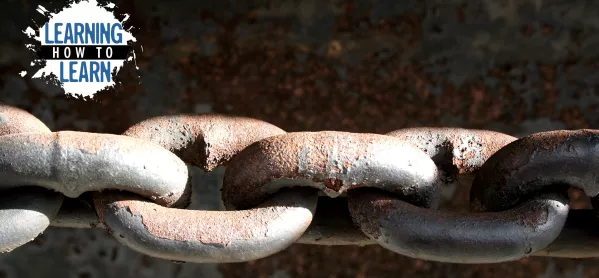Learn to learn: making links is the key to lasting knowledge
Share
Learn to learn: making links is the key to lasting knowledge
Imagine an anchor chain: the stronger the links, the more secure the boat.
That’s what we are aiming for when learning: building strong sets of brain links is important because they help students to easily handle complex information.
This article is part of a series by Professor Barbara Oakley called Learning How To Learn (L2L). A list of all the chapters will be available at this link from 16 April.
Brain links are made when axons (nerve fibres) and dendritic spines (small protusions in a neuron that connect to other neurons) link together through synapses (gaps between neurons). Students make a strong set of brain links when they learn a concept well. Their “attentional octopus” (see chapter eight) can easily zap and make a connection with a nice, solid set of brain links
Watch the below video before reading on.
A set of brain links is created gradually.
First, the working memory starts to put together and understand the new concept. After some practice, the new concept begins to feel natural - even easy. That’s because a set of brain links has been created: a nicely connected pathway in long-term memory. The axons have linked across the synapses to dendritic spines.
Easy learning
The attentional octopus can easily link to a set of brain links.
To make the connection, the octopus slips an arm out of its mental school bag - the working memory. The arm slithers through the brain’s hallways all the way over into the long-term memory locker. There, the arm gives an electrical zap to the set of links it needs. The set of brain links is activated: now the information can be used.
All the octopus needs to use is one arm. The other three arms of the attentional octopus are free. So, a student can grab on to other sets of brain links with those other arms, connecting complicated ideas or actions.
This explains how experts can think about very complex ideas and process very difficult questions even with only four “arms” of working memory.
Expert soccer players, airplane pilots, historians, musicians, mathematicians and scientists - experts of any kind - have one thing in common: lots of solid sets of brain links - short ones, long ones and everything in between.
Expert knowledge
Experts can use their attentional octopuses to easily connect to large amounts of information.
It’s important to note that just understanding a concept does not create a set of brain links, they are only really created through practice. And the way a student practises is important.
A well-linked idea feels good to practise because it’s so easy. But this can turn into “lazy learning” in which only the easy stuff is practised. The best way to learn more rapidly is to avoid lazy learning on the easy stuff. Instead, students should focus on what they find more difficult.
This article is part of a series by Professor Barbara Oakley called Learning How To Learn (L2L). A list of all the chapters will be available at this link from 16 April.
Notes by Professor Barbara Oakley and ESIC Business and Marketing School. Videos reproduced with kind permission of the Arizona State University and Professor Barbara Oakley.
For more information, see Learning How to Learn: How to Succeed in School Without Spending All Your Time Studying; A Guide for Kids and Teens.




